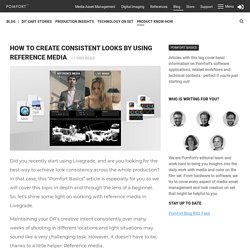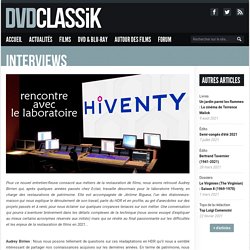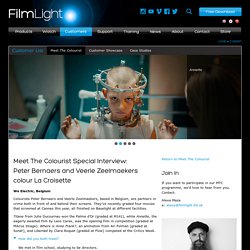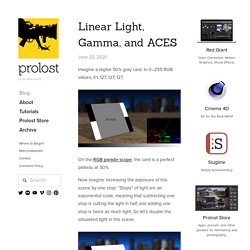

Dolby Professional Support Community. LinkedIn. Youtube. How To Create Consistent Looks by using Reference Media - Pomfort. Did you recently start using Livegrade, and are you looking for the best way to achieve look consistency across the whole production?

Chapter 1.5: Academy Color Encoding System (ACES) - Chris Brejon. Introduction The previous chapter was mainly about Color Management prior to 2014.

I am now going to describe ACES, a Color Management Workflow (CMW) developed by dozens of professionals under the auspices of the Academy of Motion Picture Arts and Sciences (AMPAS). Introduction - RxDocs - Gestion des couleurs. I - Liste d'espaces colorimétriques - RxDocs - Gestion des couleurs. Rencontre avec le laboratoire Hiventy. Pour ce nouvel entretien-fleuve consacré aux métiers de la restauration de films, nous avons retrouvé Audrey Birrien qui, après quelques années passés chez Eclair, travaille désormais pour le laboratoire Hiventy, en charge des restaurations de patrimoine.

Elle est accompagnée de Jérôme Bigueur, l'un des étalonneurs-maison qui nous explique le déroulement de son travail, parle du HDR et en profite, au gré d'anecdotes sur des projets passés et à venir, pour nous éclairer sur quelques croyances tenaces sur son métier. Une conversation qui pourra s'aventurer brièvement dans les détails complexes de la technique (nous avons essayé d'expliquer au mieux certains acronymes réservés aux initiés) mais qui se révèle au final passionnante sur les difficultés et les enjeux de la restauration de films en 2021... Audrey Birrien : Nous nous posons tellement de questions sur ces réadaptations en HDR qu'il nous a semblé intéressant de partager nos connaissances acquises sur les dernières années. LightSpace. Display Brightness Variations One of the biggest issues, specifically with PQ based HDR although HLG can be affected too, is screen brightness/luminance variations, due to a range of associated problems with the way HDR works on most displays.

The basic issue is HDR can 'change' the screen/image brightness/luminance in ways that cause fundamental variations in the viewed image, potentially in ways that distort the original artistic intent of the graded footage, as defined by the film's director and colourist. Films made for Netflix look more like TV shows — here's the technical reason why. The history of cinema as an art parallels its history as a technology.

Ever wondered why the colour in The Wizard of Oz is so saturated? Well, it wasn’t the first technicolor film, but it was the first to effectively advertise MGM’s new 3-strip colour process to a global audience. Why advertise something at half mast? This kind of technological innovation in cinema is, of course, spurred by economic motives. Meet The Colourist. We Electric, Belgium Colourists Peter Bernaers and Veerle Zeelmaekers, based in Belgium, are partners in crime both in front of and behind their screens.

They’ve recently graded four movies that screened at Cannes this year, all finished on Baselight at different facilities. Youtube. Linear Light, Gamma, and ACES — Prolost. The DSLR, even in sRGB JPEG mode, holds detail in the gray card at 3+ stops of overexposure in this case.

This is because when Canon says these JPEGs are “sRGB,” that defines their correct profile for display, but not necessarily their exact encoding. The encoding profile — the color adjustments and tone curve used to convert the linear raw sensor data to a viewable image — may be based on the sRGB curve, but it has some subjectivity baked into it; likely a little bit of s-curve contrast, and some highlight rolloff. And that’s with the “Standard” Picture Profile, sRGB, and JPEG — likely the least dynamic range this camera would ever present. Signal Ranges, Clipping, and 3D LUTs. Settings for signal ranges always loom as a source of imaging issues, especially when images are converted from RGB to Y’CbCr and back for applying 3D LUTs.

In this article, we want to give an overview of where these topics are relevant on set and how to make sure that signal and device configurations match. RGB and Y’CbCr Encoding To reproduce an image for the human observer, almost the entirety of the imaging equipment used in media production relies on two “tricks” for encoding the spectral information of a physical scene: The first trick is to subdivide the image into rectangular (typically squared) pixels. These are the smallest elements of an image, and each pixel carries the information of its color.The second trick is to encode that color with just three numbers, typically named “red” (R), “green” (G), and “blue” (B).
From the old days of analog TV, we inherited the “YUV” image encoding – with the Y’CbCr format being the variant for digital images. Metadata Journey in the Pomfort Ecosystem and Beyond – Part 3. Metadata Journey In The Pomfort Ecosystem And Beyond - Part 2. Part 2: Metadata in Silverstack At the core of Silverstack lies its metadata library.

The application supports you in collecting all necessary metadata around your movie clips: Where possible, this happens automatically. Metadata Journey in the Pomfort Ecosystem and Beyond. Part 1: Metadata in Livegrade Metadata goes hand in hand with digital content.

How a Film Color Palette Can Make You a Better Filmmaker [W/ Infographics] How can you make your film color palette part of the storytelling process? Film color palettes might be one of the most underutilized parts of your filmmaking process. It can be the difference between immersing your audience in a world or boring them to tears. We all remember the first time we saw The Wizard Of Oz. Youtube. Steve Yedlin, ASC - Director Of Photography. Youtube. CS Lupin FR. Feature Film Colour Grading with Colorist Walter Volpatto. Download Colorist Walter Volpatto’s DaVinci Resolve Feature Film Node Structure Hollywood colorist Walter Volpatto shares his DaVinci Resolve fixed node structure which he has developed while colour grading feature films and TV series such as Star Wars: The Last Jedi, Dunkirk, Green Book, The Beach Bum, Hustlers, Midway, Homecoming (TV), The Hateful Eight, Interstellar and many, many more.
Dolby Vision for Content Creators - Dolby Professional. Dolby Institute self-guided online training (free) With our self-guided educational resource from the Dolby Institute, you can work at your own pace by focusing on and revisiting the modules that are most relevant to you. The content is the same as the full live instructor-based curriculum, but using videos, graphics, and text pages with built-in logical breaks as well as testing, to make sure that you’ve understood the key concepts. Start your free training now! Live online training with a Dolby Instructor. ColorConsultants ColorConsciousness. BASELIGHT 5.3 : L'ÉTALONNAGE DES PRODUCTIONS HAUT DE GAMME. Matthieu Straub, Spécialiste Workflow chez FilmLight, fait le point avec nous sur l'actualité de leur solution d'étalonnage Baselight, les nouveaux outils proposés dans la version 5.3 sortie en décembre et les retours d'expériences des utilisateurs de plus en plus nombreux. - Quelle est la place de Baselight sur le marché français en ce début d'année 2021 ?
Matthieu Straub : Nous avons de plus en plus de clients, une vingtaine en France actuellement, et 6 ou 7 autres laboratoires avec qui je suis en discussion sérieuse. NZCS HDR MASTERCLASS. HDR Masterclass Notesby Ben Allan ACS CSI & The New Zealand Cinematographers Society. Tout savoir sur le HDR et le Dolby Vision. Moins médiatiques que l'UHD-4K, les technologies HDR (High Dynamic Range) et Dolby Vision sont pourtant tout aussi révolutionnaires pour nos téléviseurs et sans doute plus spectaculaires à l’œil que le passage de la HD à l'Ultra Haute Définition. A Guide to Shooting HDR TV: Day 6, "How the Audience Will See Your Work" by Art Adams.
This is the sixth installment of a six-part HDR “survival guide.” Over the course of this series, I hope to impart enough wisdom to help you navigate your first HDR project successfully. Each day I’ll talk about a different aspect of HDR, leaving the highly technical stuff for the end. Dolby Institute Tutorial Series - Dolby Professional. Youtube. DaVinci Resolve Tools and Productivity Hacks. Color Grading Your Short Film in DaVinci Resolve. Quick tips and golden rules for color freshmen. Getting To Know ACES Part 1: Introduction.
Update 1: Originally published April 2016, this article was updated in October, 2016 to include links to the new AcesCentral.com website. How to Emulate the Look of Film in Any NLE. Celluloid film, and the creation of motion pictures utilizing the photochemical process, has a highly specific and very nostalgic quality for many filmmakers, myself included. Inside "Ad Astra" with Colorist Greg Fisher. Ad Astra tells the thrilling story of Roy McBride (Brad Pitt), a man on a mission across an unforgiving solar system to uncover the truth about his missing father and his doomed expedition that now, 30 years later, threatens the universe. Color Management for Boutique Studios. Quick Links: Color Primer Main Article & Interviews About the Author Glossary Discussion. How to Mask a Texture in Adobe Photoshop. The origins of colour grading.
FilmLight. Qu’est-ce que le gamma ? Youtube. Is ACES right for you? by Oliver Peters. Consistent Color from DaVinci Resolve to the Internet with QuickTime Tags. Darren Mostyn. ColourSpace. Conférence HDR - Le Repaire - Partie 2 sur 4 : Corrections gamma, process HDR & début démo. Mediakwest - Paroles d’étalonneurs : 3 visions du métier... Full Levels and Video Levels Explained! - The Post Process. Youtube. HDR Preview on Set with Livegrade – Part 3.